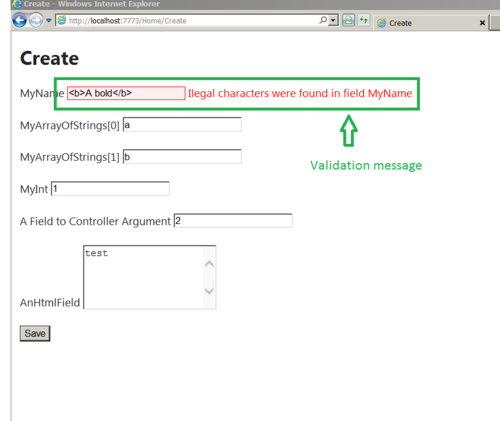

- MVC DATA ANNOTATIONS VALIDATION EXAMPLE HOW TO
- MVC DATA ANNOTATIONS VALIDATION EXAMPLE VALIDATION CODE
MVC DATA ANNOTATIONS VALIDATION EXAMPLE VALIDATION CODE
You can take advantage of data annotations to define data validation rules in a single place and thereby avoid having to re-write the same validation code again and again. Since then they have become a widely used feature in. public class Author ĭata annotations were introduced initially in. The most commonly used attributes include the following:Ĭreate the following class in a file named Author.cs in the console application we’ve created earlier. The namespace comprises several attribute classes that can be used to define metadata for your entity classes or data controls. Modeling attribute - Used to specify the relationship that exists between classes.Display attribute - Used to specify how the data should be displayed in the user interface.Validation attribute - Used to enforce validation rules on the properties of the entities.The data annotation attributes can broadly be classified into the following: The Regular expression will allow only Upper Case and Lower Case Alphabets and Numbers (Digits). The RegularExpression Data Annotation attribute accepts the Regular Expression as first parameter. Note that attributes are used to specify metadata on a class or a property. RegularExpression Data Annotation attribute. DataAnnotations namespace in your program. The Server Side validation will be performed for DropDownList using Model class and Data Annotations in ASP.Net MVC Razor.
MVC DATA ANNOTATIONS VALIDATION EXAMPLE HOW TO
To work with the code samples given in this article, you should include the System. Validation Here Mudassar Khan has explained with an example, how to perform Server Side validation for DropDownList in ASP.Net MVC Razor. 22 bookmarked Conditional ASP.NET MVC Validation using Data Annotation Attributes Talal Tayyab Rate me: 4. We’ll use this project to work with data annotations in the subsequent sections of this article. The required attribute does not have any. NET Core console application project in Visual Studio 2019. As the name implies, any field with a Required validator needs to have a value if it is to pass validation. In the “Configure your new project” window shown next, specify the name and location for the new project.In the “Create new project” window, select “Console App (.NET Core)” from the list of templates displayed.You will need to add ConditionalAttributes namespace as well. This is done in the Application_Start method.

In the file add the CustomerModelValidatorProvider to the validation providers. To start using ConditionalAttribute in your project follow these steps:Ĭopy the CustomModelValidatorProvider.cs in your project – ideally App_Start. The code file CustomModelValidatorProvider.cs is inside the project App_Start folder . In the second action method, Modify the Name and Address conditional validation are applied. The first one is Index, and in that page the data validation is applied for the login id where as for the Name and Address no validation is applied due to the conditional logic. The attached sample project contains two action methods. Public object ConstructorParam is a required field")] Public class ConditionalAttribute : Attribute asp. Starting with a form consisting of Ignite UI for MVC editor controls, this topic demonstrates how to create the form and validate the form with data annotations. ConditionalAttribute class allows definition of data annotation attributes and specifying conditions for them.

The main class is ConditionalAttribute that itself is derived from Attribute. This article will discuss the design and usage of a module that allows adding conditional logic to data annotation validation attributes. However this goes against the DRY concept. There are different workarounds, perhaps the most common one involving the use of view models for each action. So if you mark a field with the RequiredAttribute it will be required for all action methods. One big limitation of the data annotation validation approach is that they don’t have any kind of conditional logic. In projects, there will be cases when you need to have conditional validation depending on the action method or even the data. One of the proposed benefits of using this is the DRY concept (don’t repeat yourself). One of the amazing features of ASP.NET MVC is validation using Data annotations that is applied to both the client and server side. The article discusses the design of a simple module that allows declaration of conditional logic for Data annotation validation attributes Background For example, a property of type string can have various scenarios as it might hold Email address, URL or a password.


 0 kommentar(er)
0 kommentar(er)
